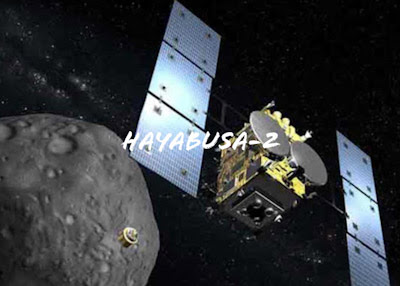On Friday, the Hayabusa-2 shuttle will despatch a couple of "wanderers" to the vast space shake known as Ryugu.
Meanderer 1A and Rover 1B will move around by bouncing in Ryugu's low gravity; they will catch pictures of the surface and measure temperatures. Hayabusa-2 achieved the space rock Ryugu in June this year after a three-and-a-half-year travel.
In the event that all goes well, Hayabusa-2 will be the primary rocket to effectively put robot meanderers on the surface of a space rock. The expansive space shake referred to formally as 162173 Ryugu has a place with an especially crude sort of space rock, and is in this manner a relic left over from the beginning of our Solar System. Contemplating it could reveal insight into the source and development of our own planet. The meanderers are put away in drum-formed holder at the base of the Hayabusa-2 "mothership". Altogether, they frame a 3.3kg science bundle known as Minerva II-1.Early on Thursday morning (BST), Hayabusa-2 started slipping towards the surface of Ryugu in anticipation of the sending.
At around 0500 BST on Friday (1pm JST) - at a separation from the space rock of around 60m - Hayabusa-2 will start the arrival of the two robots.
Japanese space organization authorities said that when the front of the drum is casted off into space, the two meanderers are then shot out from the holder and fall freely to the surface of the space rock. The 1kg self-ruling wanderers move about by bouncing, utilizing the space rock's low gravity. Every one contains an engine fueled inward mass that pivots to create compel, impelling the robot over the surface.
They're furnished with wide-point and stereo cameras to send back pictures from Ryugu. Spine-like projections from the edges of the containers are sensors that will quantify surface temperatures on the asteroid.They will send back their information to the mothership, which will then hand-off the data to Earth.
One of the foremost worries for sending is the rougher-than-anticipated surface of Ryugu, which is covered with stones with not very many smooth patches. The name Minerva originates from a separable small lander carried on the primary Hayabusa rocket, which investigated an alternate space rock - 25143 Itokawa - in the mid-2000s. In any case, a glitch amid the sending implied that little lander never achieved its objective.
Authorities and researchers from the Japanese Aerospace Exploration Agency (Jaxa), which works Hayabusa-2, will seek after better fortunes this time. Hayabusa-2 was propelled from the Tanegashima Launch Center in far southern Japan on 3 December 2014. It has been conveying a few science instrument payloads for discharge on to the surface of its objective, RyuguOn 3 October, the mothership will send a lander called Mascot, which has been produced by the German Aerospace Center (DLR) together with the French Space Agency (CNES).
Also, in late October, Hayabusa-2 will plunge to the surface of Ryugu to gather an example of shake and soil.
Considerably further on in the mission, Jaxa intends to explode a touchy charge that will punch a cavity into the surface of Ryugu. Hayabusa-2 would then plummet into the pit to gather crisp shakes that have not been adjusted by ages of presentation to the earth of room. These examples will then be sent to Earth for research center examinations.
The rocket will leave from Ryugu in December 2019 with the expectation of coming back to Earth with the space rock tests in 2020







No comments:
Post a Comment